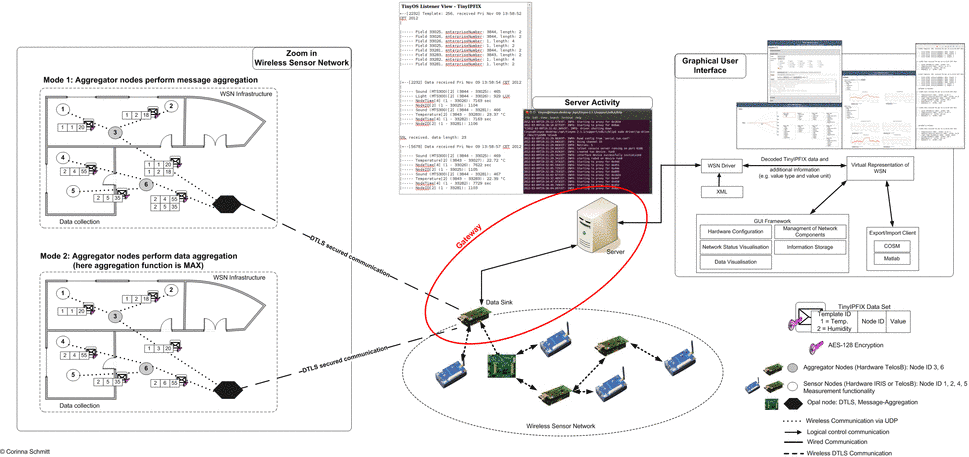Wireless Sensor Network Research
(Dr. Corinna Schmitt, Contact: Prof. Dr.-Ing. Georg Carle)
Today a growing number of applications, in
particular in the area of cyber-physical systems (CPS), depend on data
collected by wireless sensor networks. The individual nodes of these
networks have severe resource limitations, concerning storage,
processing, and transmission capabilities, but also concerning energy
available for communication functions. Supporting the required protocol
functionality in combination with the goal of energy-saving operation
typically results in the development of proprietary, highly specialized
communication protocols for wireless sensor networks.
However, with
Internet technology as the dominating communication paradigm for a wide
range of application areas, it became an attractive goal to be able to
use Internet protocols within wireless sensor networks. An
important functionality within wireless sensor networks is data
gathering and aggregation. An Internet protocol standardized within IETF
that supports this functionality is the IP Flow Information Export
(IPFIX) protocol.
The established wireless sensor network in our department integrates concepts for adapting the IPFIX protocol to the needs of wireless sensor networks have been investigated, resulting in the development of the protocol TinyIPFIX, which is an adaptation of the IP Flow Information Export (IPFIX) protocol. The new protocol has been assessed in a representative use case involving a building application. TinyIPFIX has been extended by compression capabilities and by aggregation functionality. Furthermore, extensions to support secure data transmission have been developed, using the protocol Datagram Transport Layer Security (DTLS). This solution ensures that data collected by sensor nodes is transmitted via secure channels to a global data sink, and that authorised access is ensured from a data sink to a wireless sensor network. For validation, a system has been realized that allows configuration of the networks components dynamically, and that supports visualization of the current network status and the collected data in real time.

The figure above illustrates the cooperation between all components in the established wireless sensor network. The right part "Graphical User Interface" represents the server side of the network. It shows the data flow within the interface and the offered functionalities including hardware configuration, management of the network components, network status and data visualization, and information storage. The left part illustrates room scenarios as application of the wireless sensor network. The deployed sensor nodes use TinyIPFIX for data transmission purpose throughout the network up to the gateway. Within the wireless sensor networks some sensor nodes, usually with more resources, support special functionalities, such as aggregation. The cluster heads (black diamonds) are special nodes - called OPAL - including a trusted platform module and allow a stron two-way authentication handshake in order to establish a DTLS secured communication channel to the gateway. OPAL nodes also support aggregation functionality in order to transmit more data over a secured connection to the gateway. Sensor nodes not bind to a OPAL node transmitting their data over UDP to the gateway. In order to solve this security problem a key management and secure data aggregation solution is under construction.
Operating System:
- TinyOS version 2.1.1
- BLIP support activated
Hardware and supported functionalities:
- IRIS (MTS300, MTS400) from Crossbow Inc.
- Data collection
- Forwarding
- TelosB of type CM5000-SMA from ADVANTIC SISTEMAS Y SERVICIOS S.L.
- Aggregation
- Data collection
- Forwarding
- OPAL from Commonwealth Scientific and Industrial Research Organisation (CSIRO)
- Establishment of DTLS secured connection to gateway
- Aggregation
- Forwarding
Announcement: Now open source!
- TinyIPFIX Graphical User Interface under MIT-Licence (here) - Acknowledge ment to André Freitag
- TinyIPFIX and Extentions under gpl3 and eCos Licence (here) - Ackowledgements to Thomas Kothmayr and Benjamin Ertl
Publications:
[1] | Thomas Kothmayr, Corinna Schmitt, Wen Hu, Michael Bruenig, and Georg Carle. A DTLS Based End-To-End Security Architecture for the Internet of Things with Two-Way Authentication. In Seventh IEEE International Workshop on Practical Issues in Building Sensor Network Applications (SenseApp), Clearwater (FL), USA, October 2012. |
[2] | Thomas Kothmayr, Wen Hu, Corinna Schmitt, Michael Brünig, and Georg Carle. Securing the Internet of Things with DTLS. In Proceedings of the 9th ACM Conference on Embedded Networked Sensor Systems (SenSys), Poster Session, Seattle, USA, November 2011. |
[3] | Lothar Braun, Corinna Schmitt, Benoit Claise, and Georg Carle. Compressed IPFIX for smart meters in constrained networks. Internet-Draft (work in progress), draft-braun-core-compressed-ipfix-03.txt, September 2011. [ http ] |
[4] | Alexander Klein, Lothar Braun, Corinna Schmitt, and Georg Carle. MAUS: A Multi-hop Autonomous Sensor Network for Monitoring Applications with Full IP-support. In Proceedings of the 9. GI/ITG KuVS Fachgespräch Sensornetze (FGSN), Würzburg, Germany, September 2010. |
[5] | Corinna Schmitt, Lothar Braun, Thomas Kothmayr, and Georg Carle. Collecting Sensor Data using Compressed IPFIX. In Proceedings of the 9th ACM/IEEE International Conference on Information Processing in Sensor Networks (IPSN), Poster Session, Stockholm, Sweden, April 2010. |
[6] | Thomas Kothmayr, Corinna Schmitt, Lothar Braun, and Georg Carle. Gathering Sensor Data in Home Networks with IPFIX. In Proceedings of the 7th European Conference on Wireless Sensor Networks (EWSN 2010), Coimbra, Portugal, February 2010. |
[7] | Corinna Schmitt and Georg Carle. Applications for wireless sensor networks. In Chapter in Book: Handbook of Research on P2P and Grid Systems for Service-Oriented Computing: Models, Methodologies and Applications, Antonopoulos N.; Exarchakos G.; Li M.; Liotta A. (Eds.), Information Science Publishing. January 2010. |
[8] | Corinna Schmitt, Lothar Braun, and Georg Carle. Ipfix for wireless sensors. Internet-Draft (work in progress), draft-schmitt-6lowapp-ipfix-ws-00, October 2009. [ http ] |
